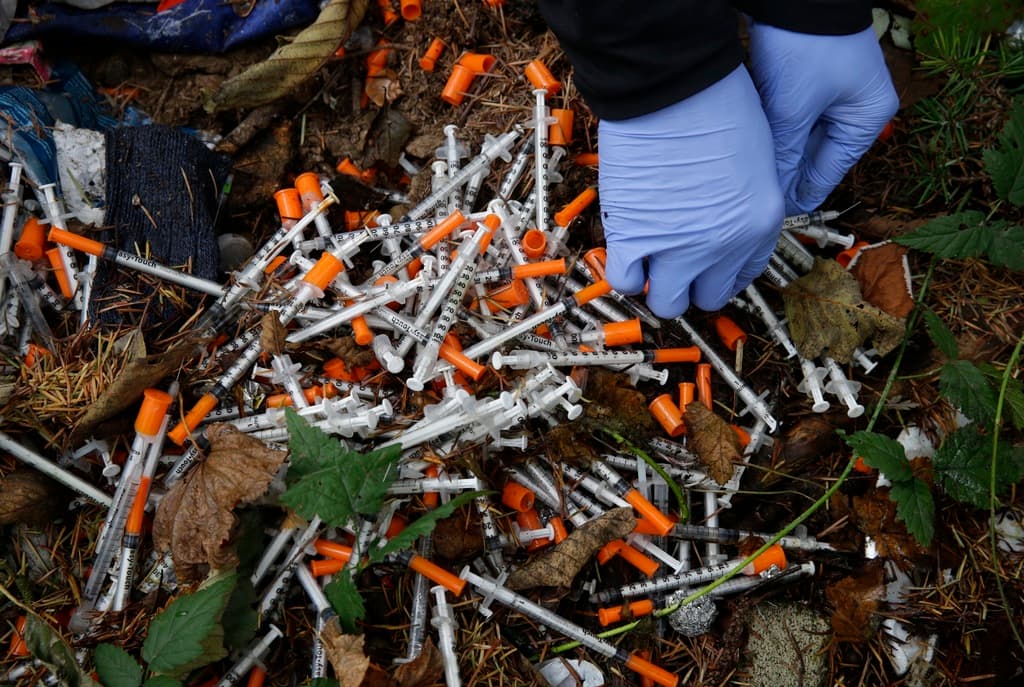Liberal West Coast Cities Are Rethinking Their Drug Policies as Casualties Mount
Bellingham, the ‘most hippie’ town in Washington, gets tough.

Bellingham, once rated the “most hippie” town in Washington State, is now getting tough on drugs — an unexpected shift for this small, liberal city near the Canadian border that voted 80 percent Democrat in the last presidential election.
The move is part of a growing backlash in west coast cities against a harm reduction-centered and anti-incarceration approach to drug policy that is seemingly failing amid skyrocketing numbers of overdose deaths and a companion homelessness crisis.
Moderates — and Republicans, where there are any — are driving similar campaigns in cities like San Francisco and Portland, where a fed-up public is pushing for a change in strategy.
“The public backlash here has been big, strong,” a San Francisco-based independent journalist and advocate for a shift away from the city’s intense focus on harm reduction, Erica Sandberg, tells the Sun. “There’s a lot of talk about evidence-based science,” she says of the harm reduction movement, “and all you see is suffering and dead bodies. The disconnect is enormous.”
The “get tough” ordinance passed by the Bellingham city council in April makes it an arrestable misdemeanor offense to “inject, ingest, or inhale” hard drugs in public — a departure from a policy of tolerance toward open use. The recent deaths of two teenagers and a five-year-old girl from fentanyl overdoses spurred the calls for action, as did complaints from downtown business owners.
“We’re not hoping to push people into the dark,” the city’s mayor, Seth Fleetwood, told the council. “We’re saying that fentanyl should not be smoked in downtown streets because it’s dangerous for the individual that’s smoking it and for public bystanders — and it’s scaring people away.”
The city of 92,000 people now averages more than two overdose deaths a day, a 70 percent increase from 2022. As in the rest of the country, fentanyl is the driving factor in these deaths. In 2018, there were only 11 overdose deaths in all of Whatcom County.
A recent Bellingham Partnership survey indicates that public safety is the number one concern of downtown business owners, with nearly half of the 53 businesses surveyed saying they plan to close or relocate from the downtown area this year.
Sounds a lot like San Francisco, where at least 20 major retailers have announced closures in the downtown area, most recently Nordstrom, Whole Foods, and T-Mobile. The drug crisis, homelessness, retail theft, public safety, the lingering effects of the pandemic, and a shift to working from home are to blame.
The Bellingham council passed the ordinance on a five-to-two vote, and even those who voted in favor were careful to say that this was not a turn toward criminalizing addiction or a return to the war on drugs. It was more, they suggested, a third way, somewhere in between the in-vogue progressive embrace of “meeting people where they’re at” and a full-on crackdown on drugs.
“This is not the war on drugs,” councilman Skip Williams, who voted in favor, said. “Nobody is going to prison for the rest of their life. … We’re facing a crisis. Right now we don’t have the tools. This gives us a tool.”
One of the two council members opposing the legislation, Kristina Martens, issued a letter to the council prior to the ordinance’s passing. In it, she says the law will push “incredibly vulnerable people who are experiencing crisis back into the shadows” by “requiring law enforcement to confiscate the only substances they can access to dull the pain of the experience and the trauma they are suffering from.”
Ms. Martens attached bullet points from the website of the Drug Policy Alliance, a leading harm reduction advocacy organization. Ms. Martens also says the drug-court system needed to divert addicted persons into treatment instead of prison is not yet established, and that that needs to be the first step. Even those in favor of the ordinance acknowledged this issue, saying diversion to treatment is the ultimate goal for offenders.
Bellingham is not the first city in Washington to pass such an ordinance, and others are now debating similar legislation. On July 1 the state’s temporary, two-year-old law classifying simple drug possession as a misdemeanor is set to expire. The law was passed after the Washington Supreme Court struck down in 2021 the state law that made simple possession a felony.
If legislators don’t compromise and pass a new bill by July 1, Washington will join neighboring Oregon as the second state in the nation to decriminalize possession. Governor Inslee has called the legislature back into session next week to address this.
“Drug policy seems stuck in a polarized debate between a war on drugs versus complete laxness about their availability and harms. We need a ‘third way,’” a Stanford University professor of psychiatry, Keith Humphreys, and former adviser to Prime Minister Johnson of Britain, Blair Gibbs, wrote this month in a Canadian paper.
“If an exclusively ‘harm reduction’ approach was the necessary pivot away from a ‘war on drugs,’ then why has a more liberalized approach not managed to save more lives? It can’t be compassionate if it doesn’t work.”
Messrs. Humphreys and Gibbs were writing about Canadian drug policy, but the Vancouver model of “safe supply,” safe injection sites, and a total embrace of harm reduction is the one to which much of the harm reduction movement in the United States is looking. Those who work in harm reduction say that it’s not that their policies aren’t working, it’s that fentanyl and a poisonous drug supply have changed the game.
Many drug users will tell you it’s impossible to find a straight bag of heroin because fentanyl, its analogs, and now Xylazine, an animal tranquilizer, have so thoroughly tainted the supply and are causing the massive increase in overdose deaths.
Those who oppose a sole focus on harm reduction say, yes, fentanyl has changed the calculus, which means pushing treatment — even mandating it in some cases — is necessary. They say the wait-until-a-person-is-ready approach of harm reduction is not suited to the age of fentanyl.
“Once you’ve started using illicit fentanyl and you’re homeless, your lifespan is about two years,” a formerly homeless fentanyl addict who is now a recovery advocate in San Francisco, Tom Wolf, tells the Sun. An arrest and the option to enter treatment instead of remaining in jail is what helped Mr. Wolf to finally get clean.
Many of the prominent online accounts that document the fentanyl and homelessness crises in San Francisco call harm reduction “an epic fail.” Others, though, pushing back against the harm reduction agenda, say the tools of harm reduction — like syringe exchange programs to prevent HIV transmission, naloxone access to reverse overdose deaths and save lives, and even fentanyl test strips to warn users when a product they are going to use may be deadly — are helpful.
Even so, they call for scrapping the activist-driven, ideological approach that opposes police enforcement or forced drug treatment and calls anyone concerned about quality of life and safety right-wing shills.
They also point out that the European countries that have legal safe injection sites — which are glorified by the harm reduction movement — also have socialized medicine, a more robust welfare state. The sites were also established in combination with greater policing of open drug scenes, as well as a system for mandated treatment in some cases.
Ms. Sandberg says harm reduction has “gone from something sensible and useful to a bastardization of the concept.” Moderates are pushing back.
“I’ve been in San Francisco for over 35 years. I know when change is coming. I can feel it. I can see it. I can taste it,” Ms. Sandberg says.
Governor Newsom just deployed the National Guard and the California Highway Patrol to crack down on fentanyl trafficking and dealing in the city. This week, the San Francisco Board of Supervisors unanimously passed a resolution calling on the mayor to fund 2,000 new shelter beds — a break from the “housing first” agenda and a sign that elected leaders are taking residents’ concerns about homeless encampments seriously.
The city is not departing from a harm reduction approach — it is still moving forward with plans to open multiple supervised drug consumption sites — yet it’s moderating its path.
The overwhelming sentiment in places like San Francisco, Portland, Seattle, and Bellingham is that whatever policies are in place now are not working. The death toll and the conditions on the streets are irrefutable evidence.
Whether the Bellingham ordinance works to reduce street drug use and improves rates of recovery for drug users remains to be seen. What is clear is that even in the most liberal cities, residents and political leaders are ready for a third way — or any way — to get out of this crisis.

